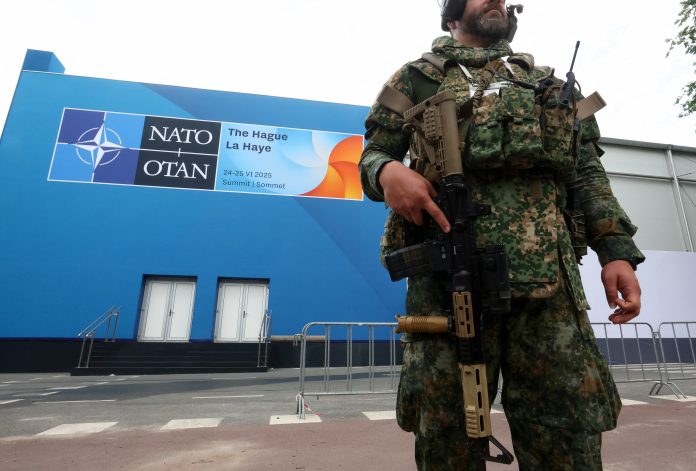Leaders of NATO countries agreed to Donald Trump’s demand to increase defence spending to 5% of GDP. The new target is to be achieved by 2035, with the proviso that budgets will be reviewed in 2029, when the US president’s term expires. Nevertheless, almost all member countries of the alliance will now be forced to at least double their military spending and probably sacrifice other budget items to cover these costs.
Europe will pay
The 5% of GDP target approved at the NATO summit in The Hague is actually divided into two parts: 3.5% should cover basic military spending (troops and weapons), and 1.5% will go to defence-related investments (infrastructure and cybersecurity). The second category, which allows for a wide range of interpretations, gives governments more opportunities to “squeeze” current expenditure items into it.
Alliance head Mark Rutte presented the agreement as a remarkable achievement for Trump. Even before the summit declaration was adopted, he sent a flattering message to the US president, which the latter shared on his social network Truth Social.
“You will achieve what NO American president has been able to do in decades. Europe will pay a BIG amount, as it should, and it will be your victory,” Rutte wrote to Trump.
Trump put forward the idea of increasing NATO military spending to 5% of GDP back in January. At the time, this figure was not taken seriously, as not all alliance members had reached the 2% of GDP target set in 2014. More than a decade later, only slightly more than two-thirds of NATO countries have achieved this goal.
The new target was met with scepticism, particularly in Spain, Belgium and Slovakia. Spanish Prime Minister Pedro Sánchez even insists that Madrid’s current military spending is “sufficient” to meet its commitments to the alliance. Spain spends the least on defence in NATO — about 1.3% of GDP.
Trump responded by threatening Madrid with trade restrictions. “They want to stay at 2%. I think that’s terrible. You know what we’re going to do? We’re negotiating a trade deal with Spain. We’re going to make them pay twice as much,” the US president said.
Unfavourable conditions
Many European countries came to the NATO summit with serious economic problems. Some of them are cutting social security and foreign aid spending to redirect funds to their military budgets. The efforts of the US’s European allies could also be hampered by Trump himself, who has started a tariff war.
All NATO countries currently spend less on defence than on health or education, according to the World Bank data. The new target could change budget priorities: if all alliance members start spending at least 5% of GDP on defence, military budgets in 21 countries will exceed spending on education.
This also applies to Europe’s leading economies — Germany, the United Kingdom and France. Europeans “can hardly afford” to fulfil the promise made at the Hague summit.
To reach the 5% GDP threshold, EU countries will have to almost triple their defence spending — from €325 billion to more than €900 billion. At the same time, the eurozone is burdened with heavy public debt, which, according to Eurostat data, amounts to 87.4% of GDP.
A significant portion of the UK budget also goes towards servicing public debt, which amounted to 101.3% of GDP at the end of 2023. London needs to find an additional £30 billion ($41 billion) for new military spending.
Harm caused by increased defence spending
The commitment of European NATO countries to increase their military budgets will harm the climate and social policy. Economists surveyed by the British publication argue that the alliance has not taken into account the risks to the security of the European continent associated with the environmental crisis and social programmes.
Germany, Poland, the Baltic states and Northern Europe are most likely to meet Trump’s 5% GDP target, François Heisbourg, a senior adviser for Europe at the International Institute for Strategic Studies in London, said. According to the analyst, France, Belgium, the United Kingdom, Spain and Italy are “absolutely unable to meet such commitments.”
Meanwhile, leader of the party Debout la France (France Arise) Nicolas Dupont-Aignan wrote on X:
“At the #NATO summit, European leaders gave in to #Trump’s blackmail. Allocating 5% of GDP to defence when the US spends 3.4% is pure madness that will ruin our countries and greatly benefit the US and Chinese economies.”
Pentagon requested $961 billion for US defence
The Pentagon has proposed allocating $961 billion for US defence needs in the 2026 financial year, according to the military department’s website.
In addition, Washington plans to spend about $60 billion on the development and maintenance of all components of the nuclear triad.
The next fiscal year in the US begins on October 1, 2025 and ends on September 30, 2026. US President Donald Trump requested $1.01 trillion for defence in his draft budget for the next fiscal year.
Earlier, Trump said he planned to cut defence spending by half.
